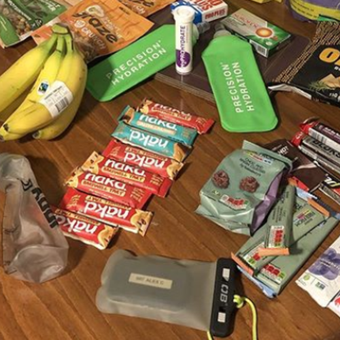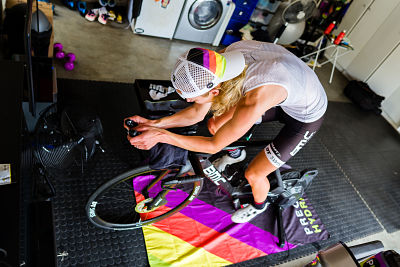‘Gut distress’ is the #1 reason for DNF (Did Not Finish) outcomes in endurance sports, with high-carb intakes reportedly the main cause. If you’ve struggled with GI issues before, it’s easy to think of your gut as something that’s fickle and sensitive and that this is ‘just the way it is’.
Sometimes it can feel like your options are:
- Fuel less and chance running out of energy and becoming dehydrated
- Fuel more and risk an upset stomach
But, despite the link between higher carb intakes and stomach issues, increased carbohydrate intakes are also associated with better performances. In fact, carbohydrate ingestion has been shown to have a ‘dose-response relationship’ with performance, so there’s much to be gained if you can tolerate greater carb intakes.
If that’s not true for you right now, good news follows... your gut can be trained.
Your gut can be trained
Whilst it’s still a developing area of research, there’s plenty of emerging evidence supporting the notion that your gut can indeed be trained, just like most other aspects of human physiology.
Consider the ‘progressive overload’ training principle. It demands that we gradually increase the stress we place on our body, particularly the muscular and cardiovascular systems, during training in order to trigger adaptations. Now apply the same basic concept to your gut.
Gut-training means challenging your gut with a higher content and volume of carbohydrates during and around exercise. Over time this improves carbohydrate absorption, glucose availability in your blood and can substantially reduce gut discomfort. All of which can translate into improved performance.
A gut-training study looked at the impact two weeks of ‘high carb’ provision (either glucose/fructose gel discs or carb-rich real foods) had on a group of runners, when compared with a placebo. Those who underwent gut-training with high-carb intakes reduced carbohydrate malabsorption and improved GI symptoms (they ran faster too, which you’d expect).

There’s also evidence that gastric emptying - the speed at which the stomach’s contents move into the intestines, where carbs and fluid are absorbed into your blood – can be improved and that your perception of fullness and bloating can be reduced.
This is perhaps best explained in the context of eating competitions. In preparation for competitions, contestants are often known to train their stomach to hold a larger volume of food with less discomfort. With this regular training, they’re able to consume volumes that are out of the question for the average, “untrained” person within such short periods of time.
FUN FACT: The #1 competitive eater (according to Google) is Joey Chestnut, who holds an impressive list of titles and records, none more so than eating 32 Big Macs in 38 minutes. He also holds the record for most hotdogs eaten (72) and chicken wings (412!). His IRONMAN time is probably not so impressive but he’s a good case study for showing what the gut can be trained to do.
What you eat matters
Dietary carbohydrate content
Since the 60s, it’s been known that eating more carbohydrate in your day-to-day diet can increase the abundance and activity of intestinal transporter, which results in an improved capacity to absorb carbohydrate.
It’s possible that the reverse may also be true, though so far that’s only been studied with animals. By restricting your carb intake and following a high-fat, or even ketogenic, diet (or by reducing your total energy intake), your daily carbohydrate intake can become very low. As a result, your intestines' capacity to absorb carbs may diminish due to the reduction of transporters.
This is something that athletes - especially those competing in endurance sports - should bear in mind. It seems fair to conclude that those athletes who aren’t currently practicing a high-carbohydrate diet could benefit substantially from training their gut.
Your gut microbiome
Your gut’s plasticity doesn’t stop with its ability to increase its absorptive capacity and tolerance to greater volumes. Research suggests that your diet composition can also have a profound - and quick - effect on the activity and composition of your gut microbiome.
Rather than evolving over millennia as humans do, your gut microbiome can change in a matter of hours, to take advantage of the environment. It’s thought that this is likely to have been crucial to our survival and development as a species back when we were hunter-gatherers.
Unlike the modern western world, where the majority of us are fortunate enough to have copious amounts of food only an arms-reach away, the food supply back then was far more unpredictable. So, our gut microbes being highly adaptable to make best use of whatever was available would have been hugely important.
This means that if you eat more carbs within a short period of time, your gut microbiome can adapt rapidly to maximise absorption rates from this food source.
How to train your gut
Many athletes hadn't raced for the best part of 18 months or even more due to the pandemic and various lockdowns, so what worked before for you nutrition-wise in the past might not work now and a period of gut re-training might be required.
It should be recognised that gut-training is an emerging area of research and has received relatively little attention in the scientific literature so far. Not enough testing has been done to agree on an optimal protocol, but some (researchers have tried to collate the current knowledge). That said, gut-training isn’t something that’s totally revolutionary by any means.
The reality is that athletes have been using variations on this theme for a long time now, knowing that more carbs can mean better performance. It’s simply that things are moving towards something more defined, less ‘hit-or-miss’.
When beginning to think about gut-training, starting with an idea of the ‘optimal’ hourly carb intake that you’d like to build up to is a good place to begin. You should know what you’re setting out to achieve before diving in.

Approaching your gut-training in a systematic way is definitely recommended. Asker Jeukendrup (a world-renowned sports performance nutritionist and the author of this paper on gut training) previously suggested that 5-10 weeks of gut-training, with a frequency of at least once a week, is appropriate.
He was sure to caveat this advice with “Please note that, in the absence of concrete evidence, this is a best guess based on information that is available”.
In Jeukendrup’s article on the topic, he proposes picking a longer training session, or the session that matches your goal intensity/duration closest, and using one of the following techniques to increase your gut’s tolerance:
- Training with relatively large volumes of fluid
- Training immediately after a meal
- Training with relatively high carbohydrate intake during exercise
- Simulating the race with a race nutrition plan
- Increasing the carbohydrate content of the diet
This is a good starting point but still doesn’t provide much information around quantities or volumes.
Since Asker made his ‘best guess’, Aitor Viribay (a performance nutritionist with World Tour cycling team, Astana) inadvertently tested a gut-training protocol when investigating the effect of high carbohydrate intake on muscle damage markers in ultra-runners.
He fueled runners with an hourly intake of either 60, 90 or 120 grams of carbohydrate. The significance of which is huge given that, up until fairly recently, a ‘ceiling’ was thought to exist where the ingestion of more than 90 grams of carbohydrate was likely to cause major stomach problems as the GI system couldn’t absorb it.
However, Viribay’s study showed (and the same has been reported by a number of elite athletes) that higher hourly carbohydrate intakes (greater than 100g/hr) can be tolerated when athletes spend time training their gut.
Viribay has described what he calls the ‘digestive system training protocol’, a six part step-by-step guide to training your gut. He suggests undertaking each “phase” for at least two weeks, completing at least two sessions in a high carb state each week.
Where you should begin on his protocol is determined by how ‘trained’ your gut already is. Have you never taken food, or high volumes of fluid, during exercise? Or do you have a history of consuming foods and fluids during training and races? Your experience level when it comes to nutrition and fluid intake will influence how long your gut training will take.
The early phases involve consuming moderate fluid volumes (~500ml) with a relatively low carbohydrate intake and then building on this, working up towards moderate-to-very high intakes of 60-120 grams of carb per hour (g/h), depending on your target number. The final phase is to train the race strategy in detail.
By looking at both Viribay and Jeukendrup’s suggested methods and drawing out the similarities, you get a good sense of what’s most important:
- Have a gut-training plan and build it up gradually (~4-10 weeks)
- Eat a high carbohydrate diet around your training
- Involve both fluids and carbohydrates when building your gut tolerance
- One to two ‘high-carb’ sessions a week is sufficient
- Simulate the race conditions (be that the race duration, intensity and/or environmental conditions) and practice your nutrition strategy in full at least once leading up to race-day
- Utilise different types of carbohydrate (for instance glucose and fructose), especially as you approach higher carbohydrate intakes

A real world example of gut training
Dr. Trent Stellingwerff, a sports scientist and research lead at the Canadian Sports Institute, published a case study on three elite marathon runners back in 2012 where he investigated their nutritional and training periodisation.
Preparations were split over three major mesocycles (training phases), covering 16 weeks in total. From weeks 7 to 16, the athletes were encouraged to focus on their carbohydrate fueling and fluid intake to aid gut adaptation.
In this time frame, on runs longer than 2 hours, athletes were instructed to consume at least ~30-60 g/h and ~400-600 ml per hour, 1-3 times per week. They were urged to progressively increase their intakes to maximise their upper tolerance.
During the final four weeks of training (called the ‘competition taper phase’), the athletes were encouraged to increase the frequency of gut-training and consume fluids and carbohydrates in every session lasting longer than 75 minutes. Around training they also ate a high-carbohydrate diet.
The end-goal was to work up to at least 60 grams of carbohydrate per hour; a good carb consumption for a runner. This was achieved on race-day, with the three athletes consuming an average of 61 grams of carbohydrate per hour and just over 600ml of fluid. No GI disturbances were reported.
Don’t forget your fluids
There’s been proportionally more talk of training your gut to tolerate more carbs up to this point but it’s important not to forget about your hydration.
When you become dehydrated, a concentrated carbohydrate fuel source (like an energy gel) hitting your GI system can cause significant discomfort and increase carbohydrate malabsorption.
With that said, as always, forcing more fluids down you to maintain your hydration status may itself lead to gut issues due to stomach overload (and other hydration-related problems), so aim to strike a balance between hydrating and tolerance.
Summing up
Gut issues are up there amongst the most frequent reasons people cite when seeking out our help at Precision Fuel & Hydration. They’ve often messed up a big race because they didn’t get their fueling or hydration strategy right and they suffered for it. We’ve heard it all, from going a little wrong, to all the way wrong… (I’ll leave the details to your imagination).
The age-old advice is to never practice anything new on race day - and this very much true with fueling and hydration. Ideally, you should never turn up to an event and follow a protocol that you haven’t fully rehearsed in training.
And the evidence that repeated practice can allow you to improve your gut’s abilities to tolerate (and absorb) carbs and fluids only strengthens the case for building some gut training into your plans...
